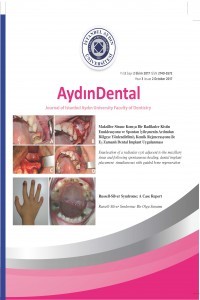ENDODONTIC TREATMENT OF MANDIBULAR PREMOLAR WITH THREE CANALS USING CBCT
Alt çene ikinci küçük azı dişi, anatomik varyasyonlar, endodontik tedavi, KIBT
ENDODONTIC TREATMENT OF MANDIBULAR PREMOLAR WITH THREE CANALS USING CBCT
___
- Cohen AS, Brown DC. Pathways of the Pulp. In: Cohen S, Burns RC. Orofacial dental pain emergencies: endodontic diagnoses and management. 8th ed. Boston: Mosby, 2002: 31- 75.
- Zillich R, Dowson J. Root canal morphology of mandibular first and second premolars. Oral Surg 1973;36:738-44.
- Prakash R, Nandini S, Ballal, S, Kumar SN, Kandaswamy D. Two-rooted mandibular second premolars: Case report and survey. Indian J Dent Res 2008;19:70-3.
- Slowey RR. Root canal anatomy- Road map to successful endodontics. Dent Clin North Am 1979;23:555-73.
- Patel S, Dawood A, Ford TP, Whaites E. The potential applications of cone beam computed tomography in the management of endodontic problems. Int Endod J 2007; 10:818-30.
- Poorni S, Karumaran C, Indira R. Mandibular first premolar with two roots and three canals. Aust Endod J 2010;36:32–4.
- Fischer GM, Evans CE. A three-rooted mandibular second premolar. Gen Dent 1992; 40:139-40.
- Alberquerque D, Kottoor J, Hammo M. Endodontic and clinical considerations in the management of variable anatomy in mandibular premolars: a literature review. BioMed Res Int 2014; 512574.
- Kim E, Marmo M, Lee CY, Oh NS, Kim IK. An in vivo comparison of working length determination by only Root-ZX apex locator versus combining Root-ZX apex locator with radiographs using a new impression technique. Oral Surg Oral Med Oral Pathol Oral Radiol Endod 2008;105:79-83.
- VenskutonisT, Plotino G, Juodzbalys G, Mickevičienė L. The importance of cone-beam computed tomography in the management of endodontic problems: a review of the literature. J Endod 2014; 40:1895-901.
- ISSN: 2149-5572
- Yayın Aralığı: Yılda 3 Sayı
- Başlangıç: 2015
- Yayıncı: İstanbul Aydın Üniversitesi
MUTAGENIC POTENTIAL OF A SELF-ADHESIVE FLOWABLE COMPOSITE
Tuğba TOZ, Zeliha AYDOĞAN, Duygu TUNCER, Emel KARAMAN
CHAIRSIDE CEREC SYSTEM AND CAD/CAM MATERIALS
İşıl Kaya BÜYÜKBAYRAM, Engin Fırat ÇAKAN, Mağrur KAZAK
NANOCERAMICS AND HYBRID MATERIALS USED IN CAD/CAM SYSTEMS
Nesrin CEREN, Volkan TURP, Faruk EMİR, Gökhan AKGÜNGÖR, Simel AYYILDIZ, Deniz ŞEN
SINGLE NO-PREP PORCELAIN LAMINATE VENEER RESTORATIONS; 2 CASE REPORTS
Volkan TURP, Simel AYYILDIZ, Deniz ŞEN, Gülcan BAHARDIRLI
PROLIFERATIVE VERRUCOUS LEUKOPLAKIA: FIVE YEARS FOLLOW-UP
Behçet EROL, Sercan KÜÇÜKKURT, Tuğçe Biçer AYTUGAR, Nihan AKSAKALLI
PULL-OUT STRENGTH OF FIBER POSTS LUTED WITH DIFFERENT SELF-ADHESIVES
ENDODONTIC TREATMENT OF MANDIBULAR PREMOLAR WITH THREE CANALS USING CBCT
Seda AYDEMİR, Alper SİNANOĞLU, İşıl Kaya BÜYÜKBAYRAM, Göze ARUKASLAN
